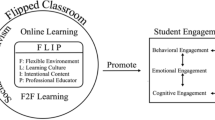Abstract
In this action research study, a flipped and non-flipped college-level mathematics classroom were compared. Participants in the flipped classroom watched video lessons outside of class and engaged in classwork problems during class. The non-flipped classroom consisted of a lecture then assigned classwork problems during class. Descriptive statistics revealed that learners preferred a flipped classroom to a non-flipped classroom and that the video lectures helped them learn the course material. A one-way ANCOVA on posttest showed no difference between learners in the flipped classroom and non-flipped classroom with pre-test scores as a covariate. Although independent samples t-test did not reveal statistically significant differences on several in-class examinations between the two groups, small positive effects showed in the flipped classroom students’ performance. Course evaluation of the two groups showed a small to large-size effect on five items, pertaining to this study. Learners in the flipped classroom perceived that the video lectures helped them to learn more mathematics compared to learners in the non-flipped classroom who did not use video lectures (p = .039).



Similar content being viewed by others
Explore related subjects
Discover the latest articles, news and stories from top researchers in related subjects.References
Barkley, A. (2015). Flipping the college classroom for enhanced student learning. NACTA Journal, 59(3), 240–244.
Bergmann, J., & Sams, A. (2012). Flip your classroom: Reach every student in every class every day. Eugene: International Society for Technology in Education.
Bishop, J., & Verlegen, M. (2013). The flipped classroom: A survey of the research. Atlanta: Proceedings of the 120 ASEE Annual Conference and Exposition paper ID #6219.
Cargile, L., & Harkness, S. (2015). Flip or flop: Are math teachers using khan academy as environed by Sal khan? Techtrends: Linking Research & Practice To Improve Learning, 59(6), 21–28. https://doi.org/10.1007/s11528-015-0900-8.
De Arujo, Z., Otten, S., & Birisci, S. (2017). Conceptualizing "homework" in flipped mathematics classes. Educational Technology & Society, 20(1), 248–260.
Frydenberg, M. (2012). Flipping excel. New Orleans: Proceedings of the Information Systems Educators Conference.
Fulton, K. (2012). 10 reasons to flip. Phi Delta Kappan, 94(2), 20–24.
Graziano, K. J., & Hall, J. D. (2017). Flipping math in a secondary classroom. Journal of Computers in Mathematics and Science Teaching, 36(1), 5–16.
Hamdan, N., McKnight, P. E., McKnight, K., & Arfstrom, K. M. (2013). The flipped learning model: A white paper based on the literature review titled A review of flipped learning. https://flippedlearning.org/wp-content/uploads/2016/07/WhitePaper_FlippedLearning.pdf. Accessed 12 June 2018.
Ichinose, C., & Clinkenbeard, J. (2016). Flipping college algebra: Effects on student engagement and achievement. Learning Assistance Review, 21(1), 115–129.
Jensen, J. L., Kummer, T. A., & Godoy, P. D. D. M. (2015). Improvements from a flipped classroom may simply be the fruits of active learning. CBE Life Sciences Education, 14(1), article 5.
Jungić, V., Kaur, H., Mulholland, J., & Xin, C. (2015). On flipping the classroom in large first year calculus courses. International Journal of Mathematical Education in Science and Technology, 46(4), 508–520.
Kirvan, R., Rakes, C., & Zamora, R. (2015). Flipping an algebra classroom: Analyzing, modeling, and solving systems of linear equations. Computers in the Schools, 32(3–4), 201–223.
McGivney-Burelle, J., & Xue, F. (2013). Flipping calculus. Primus, 23(5), 477–486. https://doi.org/10.1080/10511970.2012.757571.
Sahin, A., Cavlazoglu, B., & Zeytuncu, Y. E. (2015). Flipping a college calculus course: A case study. Journal of Educational Technology & Society, 18(3), 142–152.
Sams, A., & Bergmann, J. (2013). Flip your students’ learning. Educational Leadership, 70(6), 16–20.
Saunders, J. M. (2014). The flipped classroom: Its effect on student academic achievement and critical thinking skills in high school mathematics (UMI 3645482). Dissertation Abstracts International-A, 76(03), 128.
Selingo, J. (2013). College (un)bound: The future of higher education and what it means for students. New York: Houghton Mifflin Harcourt.
Shafique, M., & Irwin-Robinson, H. (2015). A study on the effectiveness of flipped teaching in college math classroom. International Journal of Education and Information Technology, 1(2), 29–33.
Strayer, J. (2012). How learning in an inverted classroom influences cooperation, innovation and task orientation. Learning Environments Research: An International Journal, 15(2), 171–193. https://doi.org/10.1007/s10984-012-9108-4.
Swart, W., & Wuensch, K. (2016). Flipping quantitative classes: A triple win. Decision Sciences Journal of Innovative Education, 14(1), 67–89. https://doi.org/10.1111/dsji.12088.
Van Sickle, J. (2016). Discrepancies between student perception and achievement of learning outcomes in a flipped classroom. Journal of the Scholarship of Teaching and Learning, 16(2), 29–29. https://doi.org/10.14434/josotl.v16i2.19216.
Zack, L., Fuselier, J., Graham-Squire, A., Lamb, R., & O'Hara, K. (2015). Flipping freshman mathematics. Primus, 25(9–10), 803–813.
Author information
Authors and Affiliations
Corresponding author
Additional information
Publisher’s Note
Springer Nature remains neutral with regard to jurisdictional claims in published maps and institutional affiliations.
Publisher’s Note
Springer Nature remains neutral with regard to jurisdictional claims in published maps and institutional affiliations.
Rights and permissions
About this article
Cite this article
Amstelveen, R. Flipping a college mathematics classroom: An action research project. Educ Inf Technol 24, 1337–1350 (2019). https://doi.org/10.1007/s10639-018-9834-z
Received:
Accepted:
Published:
Issue Date:
DOI: https://doi.org/10.1007/s10639-018-9834-z




